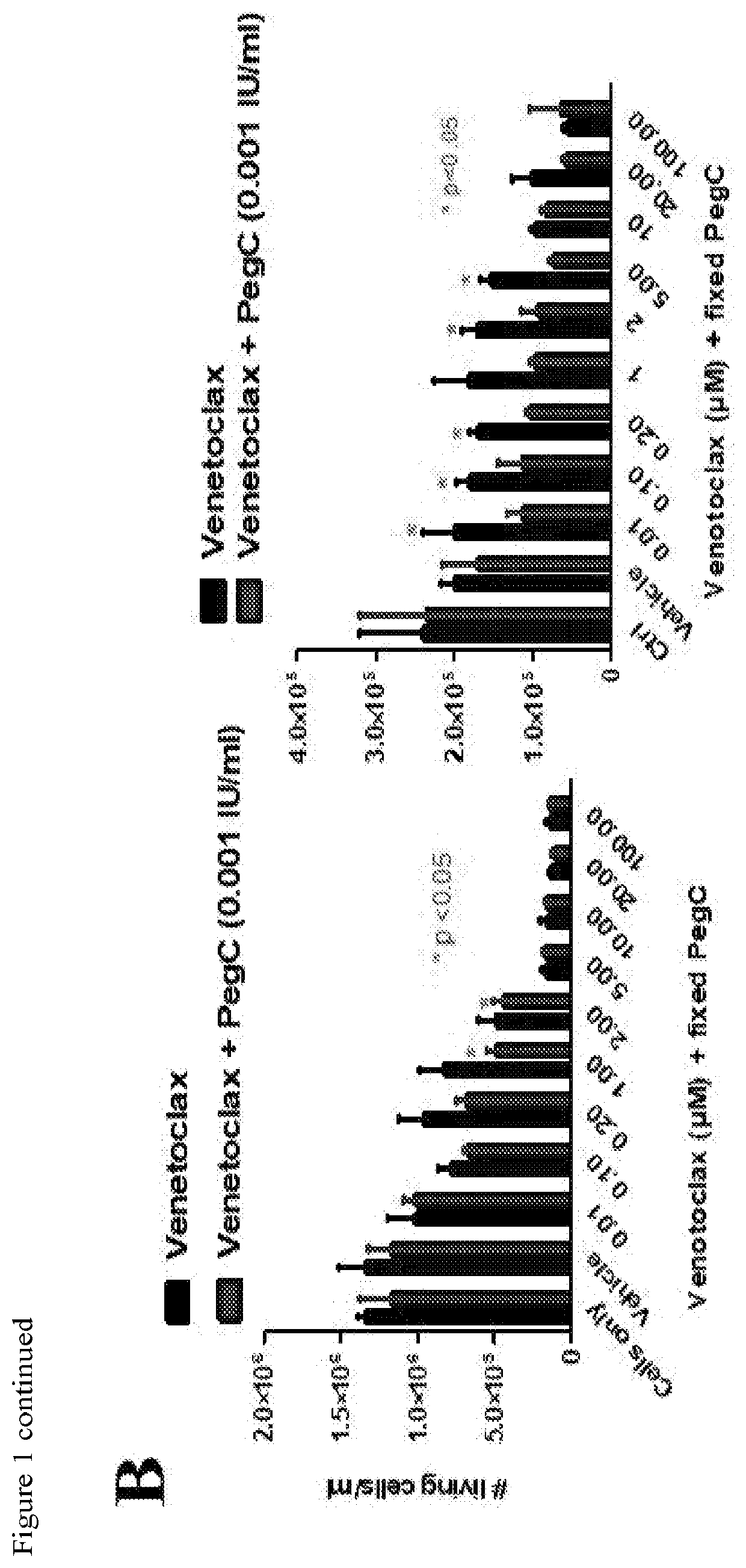Asparaginase-induced glutamine depletion combined with bcl-2 inhibition for treatment of hematologic and solid cancers
a technology of hematologic and solid cancer and glutamine depletion, which is applied in the direction of peptide/protein ingredients, drug compositions, enzymology, etc., can solve the problems of poor response rate, poor overall objective response rate, and even more difficult treatment of subsets of disease, so as to prolong the survival of subjects with the disease
- Summary
- Abstract
- Description
- Claims
- Application Information
AI Technical Summary
Benefits of technology
Problems solved by technology
Method used
Image
Examples
example 1
Activity of Ven is Significantly Potentiated by PegC In Vitro
[0117]Exposure to PegC (alone) decreased in vitro proliferation of all 7 tested human AML cell lines (HL-60, K562, MOLM-14, MonoMac-6, MV4-11, THP-1, U937)) in a concentration-dependent manner (data not shown). IC50S of PegC in the AML cell lines ranged from 0.0001 to 0.049 international unit per milliliter (IU / mL), indicating potent single-agent activity even when compared with ALL cell lines [16]. Importantly, these concentrations are pharmacologically relevant and can be achieved in patients [17].
[0118]The anti-AML activity of 12 other antineoplastic drugs was tested that, at least in theory, could be related mechanistically to PegC, including inhibitors of BCL-2, glutaminase, autophagy, proteasome, and mammalian target of rapamycin (mTOR). Proteasome inhibitors had potent in vitro activity against the AML cell panel (data not shown); co-exposure to PegC plus proteasome inhibitors demonstrated no synergy in any AML cell...
example 2
Alters Transcription and Robustly Inhibits p90RSK Transcript in AML Cells
[0123]Whole-transcriptome / gene expression profiling (GEP) was first performed in MOLM-14 cells treated with Ven, PegC or Ven-PegC using RNA sequencing (RNA-seq). Principal Component Analysis (PCA) of this transcriptomic data indicated highly correlated replicates in each treatment group and diverse clusters among different conditions (i.e. vehicle control, Ven, PegC, and Ven-PegC) on the basis of their GEP (FIG. 2A). The RNA-Seq analysis identified more than 30,000 genes in each dataset with relatively high expression levels, covering more than 92% of exonic regions. Using multivariable linear regression analysis, significant gene expression changes were observed following Ven (n=277) and PegC (n=71) monotherapy, as compared to vehicle control, as shown in the Heatmap derived from transcriptome data analysis (FIGS. 2B, 2C). A robust modification of mRNA levels (n=677) was noted after treatment with the Ven-PegC...
example 3
Enhances eIF4E-4EBP1 Interaction on Cap-Binding Complex, Inhibits Cap-Dependent Translation and Directly Impacts the mTOR Pathway
[0127]Resistance to BCL-2 inhibitors such as Ven has been linked to activation of the AKT pathway as well as upregulation of MCL-1 [27,28]. Indeed, treatment of non-Hodgkin lymphoma cell lines with PI3K, AKT and mTOR inhibitors overcame resistance to Ven by reducing MCL-1 [27]. Since asparaginase-induced glutamine and asparagine depletion was reported to hinder mTOR signaling in ALL cell lines [29], it was reasoned that co-treatment with PegC and Ven would inhibit mTOR signaling. As reported in ALL cells [29], a significant decrease in phosphorylation of p70S6K (p-p70S6K) as well as its substrate 4EBP1 (p-4EBP1) was noted upon treatment with Ven-PegC (FIG. 3B), significantly more than for each individual drug (FIG. 3B). Similar results were observed in MonoMac6 cells (data not shown).
[0128]Since these decreases in phosphorylation of mTOR substrates and in ...
PUM
| Property | Measurement | Unit |
|---|---|---|
| V/V | aaaaa | aaaaa |
| V/V | aaaaa | aaaaa |
| plasma glutamine | aaaaa | aaaaa |
Abstract
Description
Claims
Application Information
 Login to View More
Login to View More - R&D
- Intellectual Property
- Life Sciences
- Materials
- Tech Scout
- Unparalleled Data Quality
- Higher Quality Content
- 60% Fewer Hallucinations
Browse by: Latest US Patents, China's latest patents, Technical Efficacy Thesaurus, Application Domain, Technology Topic, Popular Technical Reports.
© 2025 PatSnap. All rights reserved.Legal|Privacy policy|Modern Slavery Act Transparency Statement|Sitemap|About US| Contact US: help@patsnap.com



